The Spreading Branches of Different Forms
From the “God-given seed” of poverty, chastity and obedience, “a wonderful and wide-spreading tree has grown up in the field of the Lord, branching out into various forms of the religious life lived in solitude or in community” (LG, 43). Some examples of forms of consecrated life are: Monasticism, Religious Life , Secular Institutes, Societies of Apostolic Life, Consecrated Virgins, and Hermits. Each of these forms expresses itself in a variety of different orders. Each order has a unique spirituality and charism (or “flavour”) which comes from the person who founded the order. The charism of a religious congregation refers to the distinct spirit that animates a religious community and gives it a particular character. The works (apostolates) of the community reflect the charism.
Here you can read more about different forms of consecrated life from those who are living the vocation:

“There have always been men and women, in the Church, who having known themselves to be called by God find their way to a monastery wherein live a community of people vowed to the only search that really matters, the search for God. They do this, not for themselves, but for every lost soul that will ever walk or crawl upon this earth. They actually choose to take the place of all mankind before God. No drug addict, no criminal, no one, is exempt from the unseen life the monk lives with God.
To this end they embrace a life of deep love, silence, solitude, prayer and work. They appear to be cut off from the world by their life of enclosure, by their deliberate choice to leave behind all that is nearest and dearest to them. They do not tend the obvious wounds of people as do other religious orders, rather they take up residence at the centre of people’s pain, the place where known or unknown God is closest. They do battle with the forces that seek to destroy what is good in this world, with the forces that try to distort the image of the God who so longs to draw His people to Himself. They enter into real communion with God and in time come to know Him in ways they could never have imagined. They are like trees that take in carbon dioxide and quietly turn it into oxygen. Monastic men and women make a life form with God, of changing the carbon dioxide within the heart into the oxygen of love.
This is the recipe for monastic life. It varies according to the particular order concerned, just as families differ. All provide thorough, human and spiritual training for this way of life. The road of love may be exacting from time to time but for the one called, all is joy.”

“Throughout the history of the Church there have been different forms of consecrated life; varied ways of expressing a desire to follow Christ with an ‘undivided heart’ (1 Cor 7:34). Through vows of life-long celibacy, poverty and obedience, men and women have sought to follow Christ’s own example as closely as possible. Religious life is the form of consecrated life that Catholics are most familiar with. There are many different religious orders or institutes, each of which contributes a particular gift to the life of the Church. Within religious life the main distinction is between monks and nuns who live in an enclosed convent or monastery and religious men (priests or brothers) and women (sisters) who work in the wider apostolate, for example in education, health-care or evangelization. Religious make vows of life-long celibacy, poverty and obedience (though these are named differently in some congregations.) They usually live in a community, where they support each other, in prayer, in ministry and in providing for the daily needs of each one. Each religious congregation is a public witness to one particular way of following Christ. Some religious wear a distinctive clothing or habit, others express their solidarity with those among whom they live and work by wearing ordinary clothes, often with a cross or distinctive symbol of their religious congregation.”

“Secular institutes are communities of consecrated life living in the midst of society (‘secular’ meaning pertaining to the world). Pope Paul VI called them “research laboratories in which the Church can test the concrete possibilities of her relationship to the world.” The fundamental attitude of Secular Institutes is reflected in what the Second Vatican Council calls the “sanctification of the world to a certain degree from within.” Within the world, members of Secular Institutes become “salt and leaven” and share in the Church’s task of evangelisation. The “being in the world” allows greater access to evangelise. They embrace this important task with great love. Members of Secular Institutes strive for perfection through living the evangelical councils of poverty, chastity and obedience without taking vows but rather through some form of sacred bond, for example a consecration or promise. In doing so, they bear witness to all lay people that the call to holiness is possible without taking vows.”

“A Society of Apostolic Life is a form of consecrated life within the Church. Its members pursue the apostolic purpose proper to the society and strive for the perfection of charity through the observance of the constitutions. While members of apostolic societies have community life as brothers or sisters, the mission of the community is given emphasis; members can be re-assigned among the various communities of the society as needed. Members of a Society of Apostolic Life do not take religious vows but assume the evangelical counsels. They are allowed to own personal property, but must normally live in community.
Some Societies of Apostolic Life are formed by consecrated lay people. These are men and women of the Church “in the heart of the world”. Responding to God’s call, they have consecrated themselves to Him in order to serve others in the world; influencing the world and evangelising it by virtue of their Baptism and Confirmation. By cooperating actively with grace, making a prayer of their daily lives, they strive for holiness and the perfection of charity through their apostolate.
Canon Law (canon 731) speaks of such societies as being “comparable to institutes of consecrated life”. They are regulated by the Congregation for Institutes of Consecrated Life and Societies of Apostolic Life.”

“I am a consecrated virgin living in the world a life of perpetual virginity for God, set aside as a sacred person and espoused to Christ, belonging to him alone. Consecrated virginity is a distinct form of consecrated live in the Church as stated in Canon 604 of the Canon Law. This consecration is not a vow but among the oldest sacramentals of the Catholic Church, received from the hands of the local bishop according to the Rite as set out in the Roman Ritual of a bishop. Since 1970 there has existed this special vocation for women in the Church, which was reintroduced after Vatican II, as it is one of the oldest forms of consecrated life for women in the Church. A consecrated virgin offers her whole life to the service of the Church through a life of service and has a special bond to the local Church through a spiritual bond with the local bishop who is the representative of Jesus Christ in her diocese. I live a life centered on the Prayer of the Church, a copy of which is given during the ceremony of consecration, while also earning my own living, living alone, and similar to many other consecrated virgins working in service professions as doctors, lawyers, school teachers to mention a few. We do not wear a habit or any external sign but a ring which is placed on our finger by the bishop during the consecrated ceremony as a sign of our espousal to Christ.”

The Catechism of the Catholic Church says “Without always professing the three evangelical counsels publicly, hermits “devote their life to the praise of God and salvation of the world through a stricter separation from the world, the silence of solitude and assiduous prayer and penance.” 460 They manifest to everyone the interior aspect of the mystery of the Church, that is, personal intimacy with Christ. Hidden from the eyes of men, the life of the hermit is a silent preaching of the Lord, to whom he has surrendered his life simply because he is everything to him. Here is a particular call to find in the desert, in the thick of spiritual battle, the glory of the Crucified One.” (920-921).
460 CIC, can. 603 § 1.

